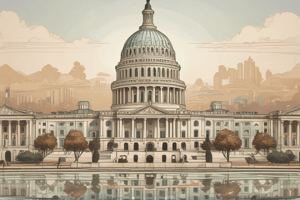Podcast
Questions and Answers
What is the broader sense of public revenue according to Prof. Dalton's definition?
What is the broader sense of public revenue according to Prof. Dalton's definition?
- Income solely from taxes and fines
- Only the revenue generated from administrative activities
- All incomes of the government during a specific period, including public borrowing (correct)
- Income derived only from public enterprises
Which of the following is NOT considered a source of public revenue?
Which of the following is NOT considered a source of public revenue?
- Private donations to a political party (correct)
- Gifts received by the government
- Fines collected from violations
- Taxes imposed on citizens
Why has the need for increased public revenue become essential in modern times?
Why has the need for increased public revenue become essential in modern times?
- To meet rising public expenditure due to expanding governmental tasks (correct)
- To reduce the number of taxes imposed on citizens
- To limit the government’s role in economic planning
- To solely focus on increasing public enterprise profits
What comprises the narrow sense of public revenue?
What comprises the narrow sense of public revenue?
Which of the following statements best captures the relationship between government income and expenditure?
Which of the following statements best captures the relationship between government income and expenditure?
What does the canon of equality in taxation refer to?
What does the canon of equality in taxation refer to?
Which principle is NOT one of Adam Smith's canons of taxation?
Which principle is NOT one of Adam Smith's canons of taxation?
What aspect distinguishes vertical equity from horizontal equity in taxation?
What aspect distinguishes vertical equity from horizontal equity in taxation?
Which of the following statements about the payment of taxes is correct?
Which of the following statements about the payment of taxes is correct?
What key characteristic of a good tax system does Adam Smith emphasize?
What key characteristic of a good tax system does Adam Smith emphasize?
What is the primary focus of a progressive tax system?
What is the primary focus of a progressive tax system?
According to Adam Smith's canon of certainty, what should taxpayers clearly know?
According to Adam Smith's canon of certainty, what should taxpayers clearly know?
What is the primary purpose of taxation in government financing?
What is the primary purpose of taxation in government financing?
What does the canon of convenience emphasize regarding tax collection?
What does the canon of convenience emphasize regarding tax collection?
How do progressive income taxes aim to address income inequality?
How do progressive income taxes aim to address income inequality?
What is the primary concern of the canon of economy in tax collection?
What is the primary concern of the canon of economy in tax collection?
Which of the following activities can taxation encourage?
Which of the following activities can taxation encourage?
What does the canon of elasticity state regarding a tax system?
What does the canon of elasticity state regarding a tax system?
What role does taxation play in stabilizing prices and curbing inflation?
What role does taxation play in stabilizing prices and curbing inflation?
What is the purpose of implementing taxes related to externalities?
What is the purpose of implementing taxes related to externalities?
What distinguishes public revenue from public receipts?
What distinguishes public revenue from public receipts?
Which of the following correctly represents the relationship between public receipts and public revenue?
Which of the following correctly represents the relationship between public receipts and public revenue?
According to the definitions provided, which element is NOT characteristic of taxes?
According to the definitions provided, which element is NOT characteristic of taxes?
What is the basis for determining the amount of tax an individual pays?
What is the basis for determining the amount of tax an individual pays?
What is a key characteristic of direct taxes?
What is a key characteristic of direct taxes?
Which of the following is an example of an indirect tax?
Which of the following is an example of an indirect tax?
What does the term 'shiftability' refer to in the context of taxes?
What does the term 'shiftability' refer to in the context of taxes?
Why are direct taxes considered more equitable than indirect taxes?
Why are direct taxes considered more equitable than indirect taxes?
What is one of the disadvantages associated with direct taxes?
What is one of the disadvantages associated with direct taxes?
How do direct taxes primarily affect individual saving and investment behavior?
How do direct taxes primarily affect individual saving and investment behavior?
What is a significant burden imposed by direct taxes on taxpayers?
What is a significant burden imposed by direct taxes on taxpayers?
Why are indirect taxes often considered more convenient than direct taxes?
Why are indirect taxes often considered more convenient than direct taxes?
Which statement accurately describes tax evasion in relation to direct taxes?
Which statement accurately describes tax evasion in relation to direct taxes?
What is a benefit of indirect taxes regarding social issues?
What is a benefit of indirect taxes regarding social issues?
How do high tax rates affect labor mobility, according to the content?
How do high tax rates affect labor mobility, according to the content?
What is a consequence of direct taxes on economic growth?
What is a consequence of direct taxes on economic growth?
What advantage do indirect taxes have over direct taxes in terms of public perception?
What advantage do indirect taxes have over direct taxes in terms of public perception?
Why are indirect taxes favored in developing countries for revenue generation?
Why are indirect taxes favored in developing countries for revenue generation?
In what way do indirect taxes mobilize savings for the government?
In what way do indirect taxes mobilize savings for the government?
Flashcards
Public Revenue
Public Revenue
The money a government collects from various sources to fund its operations and public services. This includes income from taxes, fees, fines, and profits from state-owned businesses.
What is Public Finance?
What is Public Finance?
One of the key areas of public finance that studies how governments acquire resources to fulfill their responsibilities.
How does Government get its Income?
How does Government get its Income?
Taxes are the primary source of public revenue, collected from individuals and businesses. These taxes are levied based on income, property, goods and services, and other activities.
What are Public Enterprises?
What are Public Enterprises?
Signup and view all the flashcards
What are Fees and Fines?
What are Fees and Fines?
Signup and view all the flashcards
What is the difference between public revenue and public receipts?
What is the difference between public revenue and public receipts?
Signup and view all the flashcards
Define a tax.
Define a tax.
Signup and view all the flashcards
What is Prof. Seligman's definition of tax?
What is Prof. Seligman's definition of tax?
Signup and view all the flashcards
What things can taxes be levied on?
What things can taxes be levied on?
Signup and view all the flashcards
What is the 'ability to pay' principle?
What is the 'ability to pay' principle?
Signup and view all the flashcards
Taxation and Benefits
Taxation and Benefits
Signup and view all the flashcards
Who Has the Power to Tax?
Who Has the Power to Tax?
Signup and view all the flashcards
Equality in Taxation
Equality in Taxation
Signup and view all the flashcards
Horizontal Equity
Horizontal Equity
Signup and view all the flashcards
Vertical Equity
Vertical Equity
Signup and view all the flashcards
Progressive Taxation
Progressive Taxation
Signup and view all the flashcards
Horizontal Equity in Taxation
Horizontal Equity in Taxation
Signup and view all the flashcards
Proportional Taxation
Proportional Taxation
Signup and view all the flashcards
Canon of Certainty in Taxation
Canon of Certainty in Taxation
Signup and view all the flashcards
Canon of Convenience in Taxation
Canon of Convenience in Taxation
Signup and view all the flashcards
Direct Taxes
Direct Taxes
Signup and view all the flashcards
Indirect Taxes
Indirect Taxes
Signup and view all the flashcards
Ability-to-Pay Principle
Ability-to-Pay Principle
Signup and view all the flashcards
Economic Neutrality
Economic Neutrality
Signup and view all the flashcards
Disincentive Effect of Direct Taxes
Disincentive Effect of Direct Taxes
Signup and view all the flashcards
Redistributing Income and Wealth
Redistributing Income and Wealth
Signup and view all the flashcards
Influencing Activities
Influencing Activities
Signup and view all the flashcards
Stabilizing Prices
Stabilizing Prices
Signup and view all the flashcards
Addressing Externalities
Addressing Externalities
Signup and view all the flashcards
Protecting Domestic Production
Protecting Domestic Production
Signup and view all the flashcards
Taxation and Labour Mobility
Taxation and Labour Mobility
Signup and view all the flashcards
Taxation and Business Expansion
Taxation and Business Expansion
Signup and view all the flashcards
Direct Taxes and Saving
Direct Taxes and Saving
Signup and view all the flashcards
Compliance Burden of Direct Taxes
Compliance Burden of Direct Taxes
Signup and view all the flashcards
Complexity of Direct Taxes
Complexity of Direct Taxes
Signup and view all the flashcards
Tax Evasion and Direct Taxes
Tax Evasion and Direct Taxes
Signup and view all the flashcards
Equity of Indirect Taxes
Equity of Indirect Taxes
Signup and view all the flashcards
Evasion of Indirect Taxes
Evasion of Indirect Taxes
Signup and view all the flashcards
Convenience of Indirect Taxes
Convenience of Indirect Taxes
Signup and view all the flashcards
Indirect Taxes and Forced Saving
Indirect Taxes and Forced Saving
Signup and view all the flashcards
Study Notes
Chapter Ⅰ: Meaning and Sources of Public Revenue
- Public revenue is a branch of public finance, focusing on the state's income sources.
- These sources include taxes, commercial revenues (from public enterprises), administrative revenues (fees, fines), and gifts/grants.
- Government income is crucial for fulfilling government expenditure, akin to production fulfilling consumption in economics.
- Increasing state tasks lead to increased expenditure, necessitating increased public income.
- Modern income objectives extend beyond revenue generation to impact production, employment, planning, and overall economic activity.
- Dalton defined public revenue in narrow and broad senses:
- Narrow: Taxes, public sector enterprise prices, and administrative fees.
- Broad: All government income (includes borrowing), referred to as public receipts. Public revenue is part of public receipts. Public revenue excludes repayment obligations.
Section Ⅱ: Main Sources of Public Revenue
- Diverse revenue sources are common, driven by varied needs and circumstances.
- Key sources include:
- Personal income and corporate profit taxes
- Value-added/sales taxes
- Excise taxes (on goods with inelastic demand)
- International trade taxes
- Property/asset taxes
- Payroll taxes
- Non-tax revenues (fees, charges, penalties, profits from state-owned enterprises)
Chapter Ⅱ: Taxes
Section I: Definition of Tax
- Various definitions exist, ranging from concise to elaborate.
- Examples of Tax Definitions:
- By Prof. Bartable: compulsory monetary contribution exchanged for government services.
- By Prof. Seligman: compulsory contribution for general public expenses, with no individual benefit attached.
- By Prof. Trussing: no direct quid pro quo between taxpayer and administration.
- By Prof. Taylor: compulsory payment without guaranteed return.
- By Prof. Bastable: compulsory contribution for public power.
Section II: Elements of Tax
- Enforced Contribution: Payment is mandatory, not based on consent.
- Monetary Payment (Generally): Liquidity and valuation advantages.
- Proportionate (Ability-to-Pay): Higher income = higher tax.
- Leviable on Various Subjects: Persons, property, acts, or privileges.
- Benefit not a Condition: Tax payment is not conditional on receiving specific benefit from government spending.
- Imposed by Jurisdictional Entity: Imposed by a governing body with authority over the subject.
- Legal Basis: Taxes must be lawfully established by a State's legislative body.
- Public Purpose: Funding must be for public benefit, not private profit.
Section III: Canons of Tax
-
Adam Smith's Canons:
- Equality (Equity): Tax proportional to ability to pay (progressive taxation is preferred by modern economists), aiming for horizontal and vertical equity.
- Certainty: Clear and predictable tax obligations. Taxpayers know precisely what, when, and how they owe.
- Convenience: Tax collection at times and in ways convenient to taxpayers.
- Economy: Minimize collection costs.
-
Other Canons:
- Productivity: Yield sufficient revenue.
- Simplicity: Minimize tax system complexity to avoid evasion.
- Elasticity: Flexible tax system to adjust to fluctuating government needs.
- Diversity: Many taxes to broaden revenue base.
Section IV: Purposes of Taxes
- Raise Revenue: Finance government activities; crucial for reducing reliance on borrowing. Other purposes exist besides revenue.
- Income Redistribution: Reduce income inequalities. Measures used include progressive taxation, subsidies, and selective consumption taxes.
- Encourage/Discourage Activities: Promote positive behaviors and discourage negative ones via tax incentives and penalties.
- Promote Investment/Economic Growth: Adapt tax policies to stimulate/stabilize the economy, e.g., lowering taxes during recessions, increasing taxes during booms.
- Stabilize Prices/Curb Inflation: Influence demand and supply, use taxes to reduce demand when inflation risk is high.
- Address Externalities: Taxes/subsidies to manage externalities (externalities create a burden or benefit for outside parties not directly involved)
- Protect Domestic Production/Facilitate International Integration: Taxes on imports and exports to impact domestic production and international relationships.
Section V: Classification of Taxes
-
Direct vs. Indirect Taxes:
- Direct: Paid by the tax's legal recipient (e.g., income tax). Direct burden falls primarily on the taxpayer, not easily passed on.
- Indirect: Paid by economic entities other than the legal recipient (e.g. Sales tax). The original receiver often passes the tax burden on to someone downstream.
-
Proportional, Progressive, Regressive, Degressive Taxes:
- Proportional: Tax amount is a fixed proportion of income (e.g flat tax).
- Progressive: Higher income = higher tax rate.
- Regressive: Tax rate decreases with income.
- Degressive: Mildly progressive up to certain income levels, then proportional.
-
Single vs. Multiple Taxes:
- Single: One type of tax on one thing/individual type. Proponents believe it simplifies and reduces costs. Drawbacks include limited flexibility and potential inequities.
- Multiple: Variety of taxes used, promoting equity and revenue yield. However, can increase administrative burdens.
-
Distributive, Pro-Rata, Personal, Impersonal, Specific, Ad Valorem Taxes: More nuanced forms of tax categorizations.
-
National vs. Local Taxes: National taxes apply uniformly nationwide, while local taxes vary regionally /locally based on their specific jurisdictions.
Chapter Ⅲ: Commercial Revenues
- Commercial revenue: earned income from the sale of goods and services by public agencies. Includes earnings from natural resources (e.g., mines, forests) and fees. Public enterprise revenues are treated similarly to commercial revenues from private businesses.
- Difference between tax and price: Taxes are mandatory, payments for goods/services generally proportional to the quantity used.
Chapter Ⅳ: Administrative Revenues
- Administrative revenues: fees, permits, fines, confiscations from property without heirs.
- Characterized by a lack of fixed mathematical relationship between payment and service benefit received.
- Examples include: fees, licenses, special assessments, , fines/penalties, forfeitures, escheats
Chapter I: Meaning of Public Budget
- Public budget: a fiscal document containing an outline of envisioned and authorized expenditure & revenue. It's a master plan for the following year and represents anticipated public funds.
- History and Definitions: The word "budget" emerged from Latin and French, initially describing bags used for treasury documents. Modern definitions emphasize forecasting and authorization for revenues and expenditures.
- Examples of budget definitions from various authors highlight consistent themes.
Essential Elements of Public Budget
- Prepared on a cash basis, not a ledger basis.
- Prepared on a gross basis, not a net basis.
- Usually annually based.
- Money not used in one year typically cannot be carried over.
- Combines all government revenues and expenditures.
- Uniform format.
Chapter Ⅱ: Objectives of Public Budget
- Resource Allocation: Redistribute resources to ensure public goods/services to meet societal needs where markets fail.
- Income Redistribution: Reduce disparities, often through progressive taxes and social support programs.
- Economic Development: Accelerate economic growth (tax incentives, infrastructure investments).
- Economic Stability: Control economic fluctuations (surplus budgets during booms, deficit budgets during recessions).
- Accountability: Budget provides a legislative mechanism for oversight of the executive branch.
- Employment Generation: Promotes job creation through public works, training, and job programs.
- Poverty Reduction: Alleviate poverty through targeted programs.
Chapter Ⅳ: Procedures of Public Budget
- Budget Cycle (Preparation, Appropriation, Implementation, Evaluation): A four-stage framework common to diverse governments that ensures funds are allocated, monitored and evaluated based on policy objectives.
- Preparation:
- Establishing a macroeconomic framework.
- Issuing instructions to the various governmental departments/teams.
- Receiving proposals from departments.
- Consensus building between various involved stakeholders
- Appropriation: Debate, approval, and making amendments as are needed. Includes discussions in the legislative body.
- Implementation: Stage by stage expenditure of funds during the budgetary year. Monitoring is a key function.
- Evaluation: Process to measure expenditures and examine the efficacy of the approved programs. Including an auditing phase for accountability.
Studying That Suits You
Use AI to generate personalized quizzes and flashcards to suit your learning preferences.




